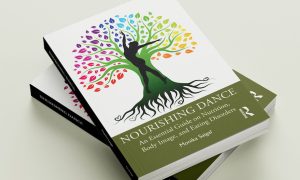By Emily C. Harrison MS, RD, LD
of The Centre for Dance Nutrition.
www.dancernutrition.com
February is heart health month. This Valentine’s day, we want to help you maintain the one muscle in your body that is always working. Making small changes to your daily routine and dietary intake will ensure that your heart is protected and in top form for rehearsals and performances.
1. Rethink the way you shop for food.
Eating “clean”, “natural” and “unprocessed” are all hot buzzwords, and are certainly a great way to show your heart some love. But how do you really put that into practice? Understanding the layout of a grocery store will keep you from selecting processed foods that could be harmful for your health in the long run. Choose fresh food items usually located around the perimeter of the store and avoid processed goods are in the aisles. If it has a long ingredient list that you can’t pronounce, you might reconsider buying it. Think through meals and snacks ahead of time, create a grocery list and stick to it, and eat a healthy snack before you shop. When you are hungry it is much harder to resist high sugar/high fat foods. The temptation to buy more products not included on your list is higher when you are hungry.
2. Eat more fiber and lower your risk for heart disease.
Young dancers might not be worried about heart disease, but studies show that even one high-fat, junk food meal can affect how the blood flows through arteries (4). Blood flow and arterial health is so important for athletes. Minimally processed or unprocessed, fiber-rich whole grains, such as steel cut oatmeal, Ezekiel bread, quinoa and other whole grain products, are essential for heart health and peak athletic performance. Your body digests fiber-containing foods slower than simple carbs. That means that your blood sugar and insulin levels will remain stable, your body will have sustained energy, and you will feel fuller longer. Fiber is also good for cholesterol levels. Research shows that fiber in whole grains lowers LDL cholesterol, or “bad” cholesterol. Fiber is also in fruits and vegetables. You will feel and dance better by eating more natural foods that are rich in fiber, vitamins and minerals.
3. Choose heart-healthy proteins.
Some fish like salmon, trout or tuna may help lower your risk of coronary heart disease. That is because they are high in omega-3 fatty acids, which may also help reduce body fat as well as keep your heart healthy.1 While fish are good sources of protein and fat, there are some concerns that they contain environmental contaminants such as mercury and PCBs, so if you eat fish, do so occasionally and choose sustainable sources (see ewg.org). Beans, nuts, seeds and soy are great sources of protein and healthy fats. Plus, they have vitamins, minerals, and cancer fighting phytonutrients.
4. Don’t deprive yourself.
Being too restrictive can backfire, and may make it harder to resist unhealthy foods. When you do want to indulge, keep portions small and consider options that also have health benefits. Dark chocolate contains high levels of flavonoids, which may improve coronary vascular function.3 Eating dark chocolate every once in a while will keep you from splurging too much later.
5. Try heart-healthy food combos.
Try some oatmeal with nuts or pumpkin seeds or whole grain toast with almond butter for a fiber-rich breakfast that will keep you full while exercising. Try whole grain pita bread with hummus, greens and a veggie burger before a show, or a fresh fruit smoothie with soy milk and flax seeds. The combination of the different nutrients will keep you full without weighing you down. Dancers should aim for 2-3 servings of fruit and 3-6 servings of vegetables per day.
Eden Morris, graduate student and dietetic intern at the Department of Nutrition at Georgia State University, contributed to this article.
Emily Harrison
 Emily Cook Harrison MS, RD, LD
Emily Cook Harrison MS, RD, LD
Emily is a registered dietitian and holds both a bachelor’s and master’s degree in nutrition from Georgia State University. Her master’s thesis research was on elite level ballet dancers and nutrition and she has experience providing nutrition services for weight management, sports nutrition, disordered eating, disease prevention, and food allergies. Emily was a professional dancer for eleven years with the Atlanta Ballet and several other companies. She is a dance educator and the mother of two young children. She now runs the Centre for Dance Nutrition and Healthy Lifestyles. She can be reached at emily@dancernutrition.com www.dancernutrition.com
Sources:
1. The Academy of Nutrition and Dietetics; www.eatright.org
2. The American Heart Association: www.heart.org
3. Flammer AJ, Hermann F, Sudano I, et al. “Dark Chocolate Improves Coronary Vasomotion and Reduces Platelet Reactivity.” Circulation. 2007; 116(21):2376–2382. doi:10.1161/CIRCULATIONAHA.107.713867.
4. Canadian Journal of Cardiology, Sept.-Oct. 2012.
Photo (top): © Elena Schweitzer | Dreamstime.com.















